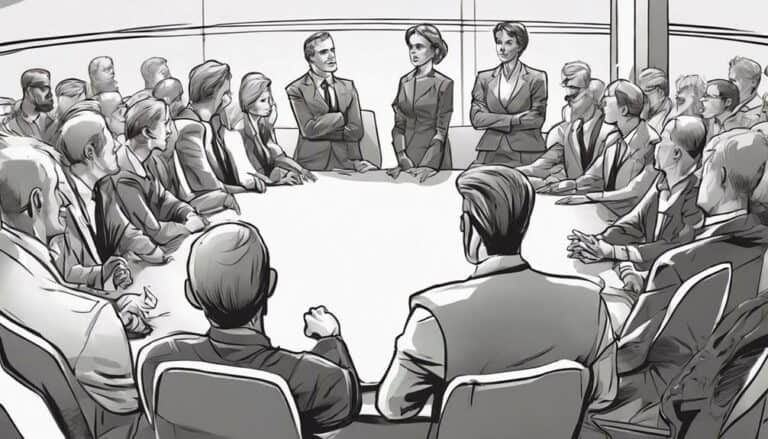Have you ever considered how active listening could be the key to unraveling the knots of communication barriers in leadership?
The impact of truly listening goes beyond mere acknowledgment; it involves understanding, processing, and responding effectively to what is being communicated.
By delving into the nuances of active listening, you may uncover a world where leadership transcends mere words and transforms into a symphony of collaboration and understanding.
Key Takeaways
- Active listening fosters understanding, trust, and empathy in leadership.
- It helps navigate conflicts effectively for better outcomes.
- Encourages open communication and enhances teamwork.
- Improves communication clarity, team dynamics, and conflict resolution.
Understanding the Importance of Active Listening
Understanding the importance of active listening is essential for leaders seeking to overcome communication barriers and foster a culture of trust and collaboration within their teams. Active listening skills are vital in communication as they enable you to truly understand your team members, building trust and empathy. By actively listening, you can navigate through conflicts effectively, leading to better resolution outcomes.
This practice also helps in creating an environment of open communication where every team member feels valued and heard. Through active listening, you can grasp the perspectives of others, enhancing teamwork and overall success within the organization. By honing your active listening skills, you pave the way for smoother interactions, improved decision-making processes, and a more cohesive team dynamic.
Embracing active listening not only benefits individual relationships but also contributes significantly to the team's collective growth and productivity.
Identifying Communication Barriers in Leadership
To effectively navigate the challenges of leadership, it's important to identify and address various communication barriers that may impede effective interaction within a team. Communication barriers in leadership encompass a range of factors, including language, physical differences, emotional cues, cultural nuances, and perceptual disparities. By actively listening and paying attention to both verbal and non-verbal cues, leaders can pinpoint these obstacles that hinder clear communication within their team.
Recognizing communication barriers is a critical step towards creating a harmonious and productive work environment. Understanding these barriers allows leaders to address factors that contribute to misunderstandings and hinder successful collaboration. Leaders who take the time to identify and address these barriers demonstrate a commitment to fostering open, transparent communication channels within their team.
In order to overcome communication barriers effectively, leaders must be proactive in acknowledging and addressing these obstacles. By creating an environment that encourages open dialogue and understanding, leaders can pave the way for improved teamwork, conflict resolution, and relationship building within their team. Addressing communication barriers is fundamental to promoting inclusivity, support, and effectiveness in communication dynamics within a leadership context.
Strategies for Overcoming Communication Obstacles
In traversing communication obstacles effectively, consider implementing tailored strategies to enhance clarity and collaboration within your team. Here are five key strategies to help you overcome communication obstacles and foster effective leadership:
- Develop Active Listening Skills: Practice active listening to understand diverse perspectives, address misunderstandings, and build trust within your team.
- Establish Guarantee Communication Channels: Guarantee open and transparent communication channels to avoid misunderstandings and promote effective information sharing.
- Encourage Nonverbal Communication: Pay attention to nonverbal cues such as body language and facial expressions to enhance understanding and strengthen rapport.
- Clarify Expectations: Clearly communicate roles, responsibilities, and expectations to prevent confusion and improve teamwork efficiency.
- Address Misunderstandings Promptly: Deal with misunderstandings promptly and constructively to prevent escalation and maintain a positive team dynamic.
Implementing Active Listening Techniques Effectively
To effectively implement active listening techniques in addressing communication barriers, consider incorporating tailored strategies to enhance clarity and collaboration within your team. Active listening is important in leadership as it fosters trust, builds rapport, and promotes understanding among team members. By actively engaging in conversations and paying attention to nonverbal cues, you can demonstrate empathy and create a supportive environment for open dialogue.
| Active Listening Techniques | Benefits |
|---|---|
| Practice reflective listening | Encourages deeper understanding |
| Maintain eye contact | Signals attentiveness and respect |
| Ask clarifying questions | Guarantees clear communication |
| Paraphrase to confirm understanding | Reduces misunderstandings |
Utilizing these active listening strategies not only improves communication clarity but also enhances team dynamics and aids in conflict resolution. By actively listening, you show your team that their voices are heard and valued, leading to increased trust and collaboration. Embrace active listening as a powerful tool in your leadership arsenal to overcome communication barriers effectively.
Achieving Communication Clarity Through Active Listening
Enhancing communication clarity through active listening consistently promotes understanding and collaboration within teams. When you actively listen, you can overcome communication barriers and gain a deeper perspective on what others are trying to convey.
Here are five key ways active listening helps achieve communication clarity:
- Suspending Judgments: By setting aside preconceived notions, you can truly grasp the speaker's message.
- Verifying Message Guarantee: Active listening allows you to clarify any misunderstandings and guarantee alignment in communication.
- Utilizing Verbal and Non-Verbal Cues: Paying attention to both verbal and non-verbal cues helps you accurately interpret the speaker's message.
- Creating Open Communication: Through active listening, you create a safe space for open dialogue, promoting clearer and more effective communication.
- Reflecting on the Speaker's Message: By reflecting on what's being said, you demonstrate understanding and encourage further discussion.
Conclusion
To summarize, active listening is a powerful tool for leaders to overcome communication barriers.
Did you know that 70% of misunderstandings in communication are due to poor listening?
By implementing active listening techniques, you can create a more inclusive and understanding environment within your team.
Remember, listening attentively and empathetically can lead to stronger relationships, clearer communication, and better decision-making.
Keep practicing active listening to enhance your leadership skills and foster a culture of open communication.

